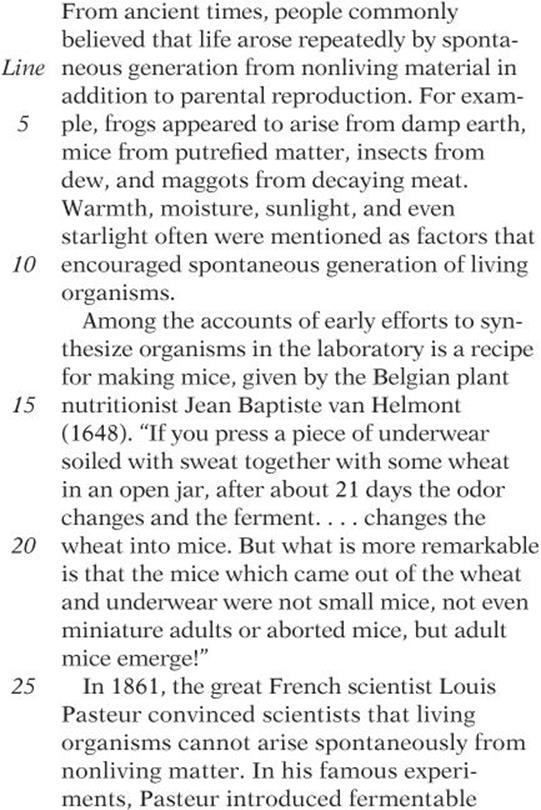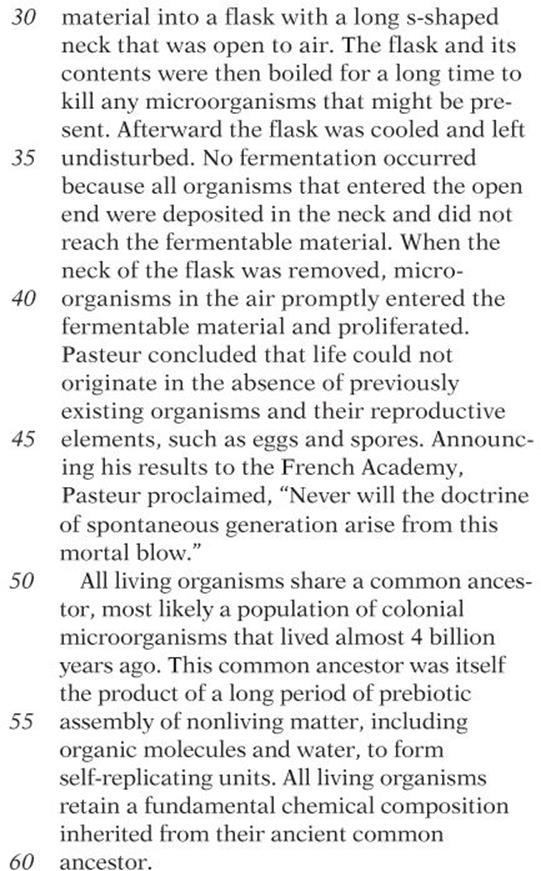SAT Test Prep
CHAPTER 4
CRITICAL READING SKILLS
Lesson 3: Finding Patterns in the Structure of the Passage
Finding the Structure of the Passage
Many SAT CR questions are structure questions such as “Which of the following best describes the overall structure of this passage?” or “What is the relationship between the third paragraph and the fourth paragraph?” They ask you to focus on the relationships between paragraphs and how they work together to convey the central idea. After you”ve found the purpose and central idea of the passage, ask “What does each paragraph or section do to support the central idea?”
A good piece of prose is like a good painting: It has an effective structure— the parts work together to create an overall effect. The basic unit of structure in a passage is the paragraph. To give another analogy, a paragraph is like a stepping-stone on a journey. Good writers make sure that each paragraph takes the reader further on the journey. No paragraph should deviate from the goal of developing the central idea.
The Structure of an Analysis
Most analytical essays have three basic parts: the introduction, the development, and the conclusion. The first paragraph of an analytical essay usually introduces the topic. A good introduction shows why the topic is worth exploring and draws the reader in by revealing interesting facts. It might describe an interesting phenomenon, a theory, or concept. If it describes a phenomenon, then the next paragraphs might give examples of it, present a theory to explain it, or describe its discovery. The passage also may describe a problem or debate related to that phenomenon.
There are many ways to structure an analysis, so pay attention. As you read, focus on the role each paragraph is playing and what devices the author uses to support the central idea. SAT questions often ask about devices, as in “The author”s reference to the “maze” (line 32) serves the same illustrative purpose as which of the following?”
The Structure of an Argument
There are many ways to prove a point. For instance, if you want to persuade your readers to support gun control, you might tell a tragic story of a gun-related death, cite government statistics about gun violence, refer to a study about the behavior of people when they have guns versus when they don”t, or discuss the effectiveness or ineffectiveness of past gun policies and education programs. Each of these is a different rhetorical device for persuading the reader. Noticing the choices a writer makes when constructing an argument makes you not only a better reader but also a better writer.
When reading an argument, pay attention to the rhetorical devices the author uses with a critical eye. Are they convincing to you? Are the examples strong? Is the reasoning sound? Asking these questions helps you to read more actively. Furthermore, reading critically prepares you to answer higher-order questions such as “Which of the following, if true, would suggest a basic flaw in the author”s reasoning?” or “Which of the following elements is NOT used in this passage?”
The Structure of a Narrative
As we discussed in the last lesson, every narrative has the same basic skeleton: The conflict is introduced, then developed, and then resolved. This is helpful to remember because paragraphs don”t work the same way in narratives as they do in other kinds of prose. For instance, in an essay, a new paragraph signals the start of a new idea, but in a narrative, it also may signal a new line of dialogue or a new scene.
To understand the structure of a narrative, continually ask “How does this dialogue or description introduce, explain, develop, or resolve the conflict?” For instance, a description of a fight between friends establishes a conflict. A paragraph about a character”s inner thoughts about the fightdevelops the conflict. And a dialogue in which the friends make up resolves the conflict. Look for such key points in every narrative you read.
Concept Review 3: Finding Patterns in the Structure of the Passage
1. What is the “structure” of a passage?
2. What is the basic unit of structure in a passage?
3. What are the three basic parts of most analyses?
4. What are the three basic parts of most narratives?
5. Name four kinds of rhetorical devices that an argument might use.
SAT Practice 3: Finding Patterns in the Structure of the Passage
The following passage, from a text on the principles of zoology, discusses theories of biogenesis, the process by which life forms are created.


1. Throughout the passage, the word “spontaneous” can best be taken to mean
(A) without reproductive elements
(B) in a medium
(C) unthinking
(D) free-spirited
(E) adult
2. In Pasteur”s experiment, why was the neck of the flask removed?
(A) to allow the air to escape
(B) to provide access to microorganisms
(C) to kill any microorganisms that may be present
(D) to permit the heating of the flask
(E) to introduce fermentable material
3. In line 49, the word “mortal” most nearly means
(A) human
(B) impermanent
(C) fatal
(D) earthly
(E) malicious
Cleveland Hickman, Larry Roberts, and Allan Larson, Integrated Principles of Zoology. © 2001 McGraw-Hill. Reprinted by permission of The McGraw-Hill Companies.
4. If both Pasteur”s conclusion that “life could not originate in the absence of … eggs and spores” (lines 42–45) and the statement, “This common ancestor … units” (lines 53–57) are true, then which of the following statements also must be true about “prebiotic assembly” (lines 54–55)?
(A) It is not a “spontaneous” process.
(B) It does not depend on sunlight.
(C) It produces molecules unlike those in current life forms.
(D) It occurs in the absence of water.
(E) It occurs very quickly.
5. The author of this passage would likely agree with all of the following statements EXCEPT
(A) Jean Baptiste van Helmont”s efforts to synthesize organisms were poorly controlled.
(B) Life on earth began about 4 billion years ago.
(C) Nonliving matter cannot form units that can reproduce themselves.
(D) The chemical makeup of organisms must be fundamentally similar to that of their parents.
(E) Carefully controlled experiments can disprove even widely held biological theories.
6. The theory of biogenesis described in lines 50–60 shares what common element with the theory of spontaneous generation described in lines 1–11?
(A) a single common ancestor
(B) water as an essential reactant
(C) the process of fermentation
(D) sexual reproduction
(E) decaying organisms
Answer Key 3: Finding Patterns in the Structure of the Passage
Concept Review 3
1. The structure of the passage is the way that individual paragraphs work together to convey the central idea of the passage.
2. The paragraph
3. The introduction, the development, and the conclusion
4. The introduction of the conflict, the development of the conflict, and the resolution of the conflict
5. Studies, authoritative quotes, anecdotes, statistics, logical analysis, examples, etc.
SAT Practice 3
1. A The theory of “spontaneous generation” is described as one in which life arises from substances that do not contain the reproductive elements of that life form.
2. B The important difference between the flask with the neck intact and the flask with the neck removed was the presence of microorganisms in the fermentable material. When the neck was removed, “microorganisms in the air promptly entered the fermentable material and proliferated.”
3. C The experiment, Pasteur claimed, “killed” the theory of spontaneous generation, so it dealt a fatal blow.
4. A The “prebiotic assembly” is said to occur over a “long period.” This must not be an example of “spontaneous generation,” that is, generation of life over a short period of time from nonliving material, because the theory of spontaneous generation has been disproven.
5. C The author clearly believes that van Helmont”s study was poorly controlled and that controlled experiments can disprove widely held theories because van Helmont”s theory was refuted when Pasteur imposed tighter controls. He also states that all living organisms derived from an ancestor “that lived almost 4 billion years ago” (lines 52–53) and that they “retain a fundamental chemical composition inherited from their ancient common ancestor” (lines 58–60). However, the author would not agree that “nonliving matter cannot form units that can reproduce themselves” because he describes just such matter in lines 53–57.
6. B The theory of spontaneous generation described in lines 1–11 mentions “damp earth,” “dew,” and “moisture” as “factors that encouraged spontaneous generation.” The theory of biogenesis described in lines 50–60 states that water is an essential element of prebiotic assembly.